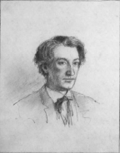Van Gogh Museum Journal 1996
(1996)– [tijdschrift] Van Gogh Museum Journal–
[pagina 164]
| |
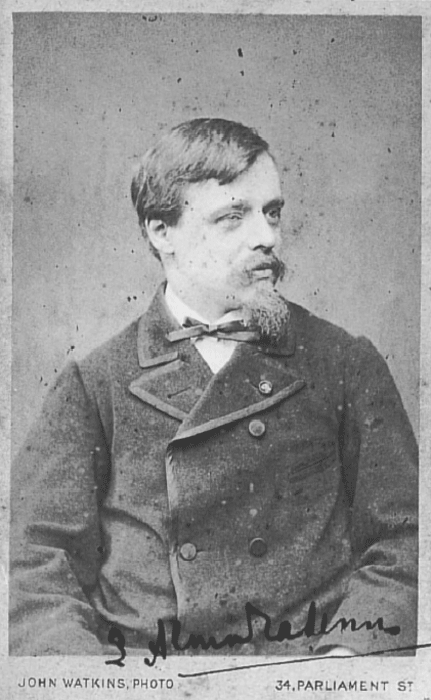 fig. 1
John Watkins, photograph of Lawrence Alma-Tadema, private collection | |
[pagina 165]
| |
The Exhausted maenads: Lawrence Alma-Tadema and Carel Vosmaer
| |
[pagina 166]
| |
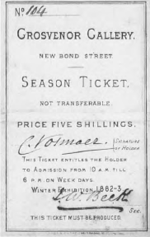 fig. 3
Carel Vosmaer's season ticket for the winter exhibition of 1882-83 at the Grosvenor Gallery in London, Amsterdam, Rijksmuseum, Rijksprentenkabinet | |
The ‘Maenads’When Alma-Tadema entered 130 works to the large winter exhibition at the prestigious Grosvenor Gallery in 1882-83, Vosmaer not only visited the exhibition (fig. 3) but was also a guest in the artist's home, the famous Townshend House on the edge of Regents Park. In describing the house, Vosmaer wrote: ‘There is no need to search for it, for it immediately reveals itself, with its coloured frames around the doorposts, its “Hail!” above the door, its colourful balcony and pillars draped in ivy. There it stands, the charming villa amid its gardens, in one of the large parks of which there are many in London, oases within the colossal stone mountain of the city, which alters the measure of human standards.’Ga naar voetnoot5 Vosmaer reviewed the exhibition at length in De Nederlandsche Spectator.Ga naar voetnoot6 For years he had been planning a catalogue raisonné of Alma-Tadema's work, and for this reason he took an interest in anything and everything the artist did. All the bits of information he collected were entered on cards, but the planned publication never materialised.Ga naar voetnoot7 One of the paintings shown at the exhibition was After the dance (fig. 4), then owned by H.F. Makins. A note in Vosmaer's own catalogue reads: ‘firmly modelled - soft brown flesh - warm - delightful tone against the brown-black bearskin. Dark clay pot with garland - thyrsus with yellow bands.’Ga naar voetnoot8 These notes were intended for his exhibition review, where he finally described the painting as follows: ‘a nude Bacchante with a tambourine and thyrsus staff lying on the ground. The sleeping body, warm brown in hue, rests upon the black-brown bearskin. In the drawing and modelling of the nude this is surely one of the most excellent of the artist's works [...].’Ga naar voetnoot9 Vosmaer considered the body of this bacchante, lying exhausted on the ground, ‘gloriously painted, warm and yet bright in the contrast with the dark skin of the bearskin on which she rests, together with tambourine and thyrsus.’Ga naar voetnoot10 He examined the most significant of the numerous works on show in similar fashion. At home, in Townshend House, Alma-Tadema brought out a number of unfinished canvases ‘large and small’ to show his guest, including the work recently acquired by the Van Gogh Museum, Exhausted maenads after the dance (fig. 5).Ga naar voetnoot11 The painting depicts three Bacchantes, lying asleep on the ground, ‘tired out by the frenzy.’ The nude woman closest to the viewer corresponds in every respect to the maenad portrayed in the completed painting After the dance, which Vosmaer had just seen at the exhibition. In the diary which he kept during his London visit Vosmaer made a drawing of the work | |
[pagina 167]
| |
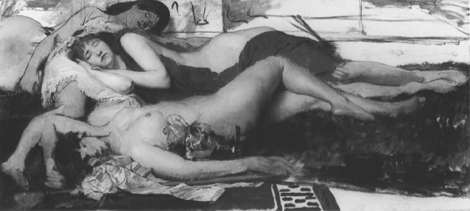 fig. 5
Lawrence Alma-Tadema, Exhausted maenads after the dance, c. 1875, Amsterdam, Van Gogh Museum 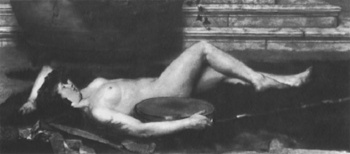 fig. 4
Lawrence Alma-Tadema, After the dance, 1875, private collection | |
[pagina 168]
| |
 fig. 6
Vosmaer's pencil sketch of Alma-Tadema's painting Exhausted maenads after the dance, private collection (fig. 6) and wrote of the unfinished ‘sketch’: ‘It represents [...] something from Plutarch, I can't remember exactly what; women who had taken part in the festival of Bacchus and, exhausted, fell asleep in the marketplace. I'll have to look it up, I said, probably in the scripta moralia. And later I found it. He [Alma-Tadema] has made me a present of the lovely sketch. I am enclosing the story (see Plutarch on the virtues of women).’Ga naar voetnoot12 Vosmaer's note on the passage from Plutarch is no longer in the Vosmaer archives. However, we do know that the painter borrowed the theme from Plutarch's Ethica or Moralia, a series of 79 discourses on understanding mankind in which the author discusses virtue and vice, religion, philosophy, and the arts and sciences. The passage Alma-Tadema used for his painting (from the chapter entitled ‘Mulierum virtutes’: Bravery of women) deals with the women of Phocis, a mountainous landscape in central Greece. Plutarch says of them: ‘When the despots in Phocis had seized Delphi, and the Thebans were waging war against them in what has been called the Sacred War, the women devotees of Dionysus, to whom they give the name of Thyads, in Bacchic frenzy wandering at night unwittingly arrived at [the city of] Amphissa. As they were tired out, and sober reason had not yet returned to them, they flung themselves down in the market-place, and were lying asleep, some here, some there. The wives of the men of Amphissa, fearing, because their city had become allied with the Phocians and numerous soldiers of the despots were present there, that the Thyads might be treated with indignity, all ran out into the market-place, and, taking their stand round about in silence, did not go up to them while they were sleeping, but when they arose from their slumber one devoted herself to one of the strangers and another to another, bestowing attentions on them and offering them food. Finally, the women of Amphissa, after winning the consent of their husbands, accompanied the strangers, who were safely escorted as far as the frontier.’Ga naar voetnoot13 It is not clear what led Alma-Tadema to choose this theme. We may assume that he did not consult Plutarch every day; moreover, the Moralia was not in his own library. In Antiquity, the maenads were often shown on vases and works of sculpture, and both Rubens and Poussin represented them regularly. The artist turned to the same subject again in 1887 in The women of Amphissa (fig. 7), but this | |
[pagina 169]
| |
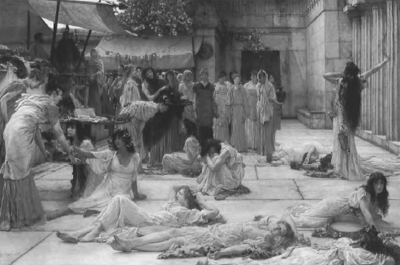 fig. 7
Lawrence Alma-Tadema, The women of Amphissa, 1887, Williamstown, Mass., Sterling and Francine Clark Art Institute work is much less daringly painted than the previous two versions. In this large canvas, measuring 122 × 183 cm, Plutarch's account is followed literally, and the artist depicts the moment when the maenads awake. Alma-Tadema was apparently quite fond of this story, for in his studio in Grove End Road, where he moved in 1885, he had a copper relief by William Reynolds-Stephens on the same theme.Ga naar voetnoot14 Almost all the paintings that left Alma-Tadema's studio were finished works and thus tell us little about the artist's working methods. Exhausted maenads is an exception. He set out the composition with rough brushstrokes, and then began working out the bodies of the first two figures in the foreground. The attributes, such as the thyrsus (a long staff decorated with foliage and ribbons and crowned with a pine cone), the tambourine and the bowl, are still only a suggestion of their ultimate form. The way in which the painter built up his figures against a light background - his preferred manner - is apparent in this unfinished work, and is also referred to in a letter to Vosmaer dated 11 February 1875. In it he made a small sketch of a reclining female figure that bears a resemblance to the maenad draped in red. As he wrote, he intended to do a lithograph of this figure: the first stone would contain ‘the outlines of the figures and objects [...] sketched,’ and would be printed on white paper. A second stone would then be prepared ‘with a solid blue for the surface outside the contours’ (fig. 8).Ga naar voetnoot15 It is clear that in 1875 Alma-Tadema was deeply involved with the theme of the resting maenad, and this would appear to justify the dating of the Van Gogh Museum's painting. In Exhausted maenads after the dance there is little trace of his usual sophisticated style, which sometimes renders his work a trifle dry and ‘over-refined.’ We do not know why the canvas was never completed. It has been suggested | |
[pagina 170]
| |
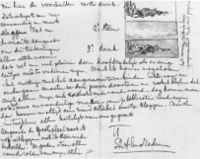 fig. 8
Sketch by Alma-Tadema and proposal for a lithograph in a letter to Carel Vosmaer, 11 February 1875, Amsterdam, Rijksmuseum, Rijksprentenkabinet that the artist's dealer, Ernest Gambart, did not want him to give away completed works.Ga naar voetnoot16 In any case, Vosmaer was extremely fond of this ‘sketch’; he had it mounted in a sober gold frame and hung above one of the bookcases in his study at 73 De Ruyterstraat in The Hague, so that he could see it from behind his desk (fig. 9). After his death, the work remained in the Vosmaer family for over a hundred years.Ga naar voetnoot17 | |
Collections of books and photographsMany of Alma-Tadema's motifs were based on classical or medieval sources. He had a large library, consisting of over 3000 titles, many of which dealt with Classic Antiquity. Moreover, he had at his disposal an enormous collection of photographs and other reproductions, including over 160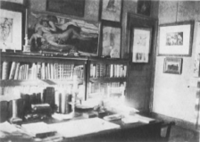 fig. 9
Carel Vosmaer's study in the house at 73 De Ruyterstraat. The unfinished Exhausted maenads after the dance can be seen above the bookcase. Private collection portfolios with photographs arranged according to subject. After his death, this collection was donated to the Victoria and Albert Museum, together with his library. In 1947 the museum transferred both photographs and books to the Special Collections Department of the Birmingham University Library.Ga naar voetnoot18 The photograph collection features views of a great many Egyptian, Greek and Roman monuments. The themes range from complete buildings to architectural details; the sculptural work on pediments, metopes, and other structural components is also well represented. Besides the many anonymous photographs, there are prints by J. Pascal Sébah, Maxime Du Camp, Francis Bedford, Félix Bonfils, Auguste Salzmann, William James Stillman,Ga naar voetnoot19 James Robertson and Felice Beato. The collec- | |
[pagina 171]
| |
tion also contains photographs of art objects from the Musée Cluny by Paul Robert, and the porch of the Notre-Dame by Bisson Frères. In addition, there are portfolios of animals, plants and flowers, trees, overcast skies, hairstyles, costumes, etc. Most of the flowers were done by the London photographer Frederick Hollyer. Nor was the aritst's interest confined to Europe and the Middle East. There are various views of India by Bourne and Shepherd, and an album of 45 photographs by Isidore van Kinsbergen, with a dedication to Alma-Tadema (dated 31 March 1870).Ga naar voetnoot20 He also owned a small collection of Japanese prints, some by Hiroshige. At the back of several of these portfolios are signed drawings by Alma-Tadema, which illustrate how he used the images. Not only did he use motifs taken from photographs,Ga naar voetnoot21 he also had the Belgian photographer Joseph Dupont, who lived in the same house in Brussels, photograph his works as they were nearing completion. The painter used these photographs to correct compositional and tonal differences, in order to harmonise the various components of the painting.Ga naar voetnoot22 Whenever Alma-Tadema needed further textual or visual details on one of the classical themes he was painting, he could always call on his friend Vosmaer in The Hague. He, too, had a collection of photographs, albeit much smaller, which consisted primarily of ancient statues and monuments. Many of these had been purchased from Fratelli Alinari. He also had a number of photographs and a stock list of Roman sculptures and monuments by the English photographer James Anderson.Ga naar voetnoot23 Moreover, he could draw from his large collection of reproductions, which reveals a particular interest in ornament. On occasion he was able to assist his friend by searching out passages from classical writers or illustrations which the painter wanted to incorporate into this or that work. Vosmaer's library, which was at least the equal of Alma-Tadema's, is unfortunately no longer intact.Ga naar voetnoot24 | |
Gérôme's preparationsUntil recently, nothing was known about the type of paint Alma-Tadema used. Because his canvases were regularly painted over and worked up, they often exhibit a great deal of craquelure. He referred to this in a 1902 letter to Dr J. Six, explaining that the work entitled Queeen Fredegonda at the deathbed of Bishop Praetextatus was the last in which he had employed ‘boiled oil.’ Up until then, the paint on several of his works had shown signs of cracking. ‘As you perhaps know, my Venantius Fortunatus was brought here from the museum in Dordrecht some years back, and restored while I looked on. The poor thing did look frightful, all full of cracks. It must have been hung over a stove or something similar, as it was painted using the same colours and oils as Fredegonda, and only three years earlier.’Ga naar voetnoot25 When his work was exhibited in Paris in 1865, Alma-Tadema had paid a visit to Jean-Léon Gérôme ‘in order to hear from him which preparations he used for his painting. [...] I learned from him how to paint with Copal à l'huile: the varnish protects the colours against the influence of the atmosphere but when mixed with oil does not prevent the oil from evaporating. Since then I have always used this Copal à l'huile de Durosin.’Ga naar voetnoot26 We know little more than this about his use of paint. | |
[pagina 172]
| |
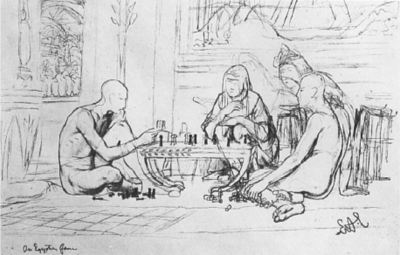 fig. 10
Woodbury type portrait of Lawrence Alma-Tadema that appeared in Vosmaer's Onze hedendaagsche schilders 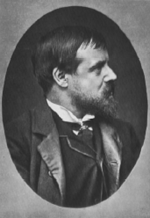 fig. 11
Lawrence Alma-Tadema, An Egyptian game, 1865, Amsterdam, Rijksmuseum, Rijksprentenkabinet | |
‘Our modern painters’In 1881 Vosmaer embarked upon a series of prose sketches entitled Onze hedendaagsche schilders (Our modern painters).Ga naar voetnoot27 Each instalment opened with a portrait executed in woodbury type (fig. 10). Vosmaer then discussed the career of the various artists (based on a previously completed questionnaire), and provided a more or less chronological overview of their work. In some cases he did not confine himself to factual information, but also made value judgements. In most cases, these were quite positive. Alma-Tadema was the subject of the fourth volume, and Vosmaer's opinion of his work was naturally very high. Three of the four drawings reproduced here were gifts to Vosmaer from his artist friend.Ga naar voetnoot28 One of these, An Egyptian game, dating from 1865 (fig. 11), is linked to one of the Egyptian scenes the painter had been doing since 1863. The two others (figs. 12 and 13) are studies for the paintings | |
[pagina 173]
| |
 fig. 12
Lawrence Alma-Tadema, Study of a seated figure for ‘The pyrrhic dance,’ 1869, Amsterdam, Rijksmuseum, Rijksprentenkabinet The pyrrhic dance (Guildhall Art Gallery, London) and Last roses (present location unknown). Vosmaer wrote of it: ‘Here we see several Greek men in full armour and the high-crested feathered helmet, such as none of the more recent painters would have dared to depict, performing their war dance [...] while youths and respectable greybeards sit under the stoa, enjoying the spectacle. Very Greek.’ The drawing Last roses portrays ‘a young woman who offers the last roses of summer upon a white marble altar.’Ga naar voetnoot29 What is missing from this last part in the series is the personal note, such as can be found in Vosmaer's long description - as yet unpublished in English - of Alma-Tadema's villa just after it had been severely damaged as a result of a gunpowder explosion. In his column ‘Een en ander’ (One thing and another) in Het Vaderland Vosmaer wrote: ‘The devastation was terrible. The entire roof has been destroyed, the walls cracked, all the windows, glass and frames have been smashed, as well as the doors; even the one-inch-thick front door lay in the hall, broken in two. Everything was strewn with glass and plaster from the ceiling [...] At the moment they [Alma-Tadema and his wife] are 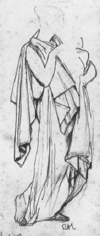 fig. 13
Lawrence Alma-Tadema, Study for ‘Last roses,’ 1872, Amsterdam, Rijksmuseum, Rijksprentenkabinet living in a kind of ruin, in the lower portion of the house. In the studio, which was painted entirely in Pompeian style, three-quarters of the ceiling has come down. The whole house was furnished with the most exquisite taste, and decorated with the extraordinary refinement which so characterises this painter of life in Classic Antiquity. Colours, decorations, shapes, arrangements - all evoke the atmosphere of Pompeii and Herculaneum, although modern comfort has in no way been sacrificed. The unusual colours and typical patterns of the fabrics, the coloured carpets hung low along the walls, the ceilings and the parquet floors, the ambiance and the light which dominates each and every room, the ingenious decoration, handsome bronze and china pieces, and the various paintings all bear the stamp of the owner's imagination. Upstairs there [was] a salon in which two columns add[ed] to the impression of a Pompeian casa. Adjacent to this salon [was] the painter's studio, illuminated by one large window. Here and there a sketch or study [hung] on the wall; the bookcases contain[ed] magnificent reproductions and his treasury of books, all of which bear witness to his profound study of Antiquity; canvases and | |
[pagina 174]
| |
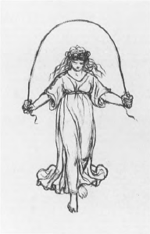 fig. 14
Lawrence Alma-Tadema, Girl jumping rope (wall decoration for his studio). This chalk drawing was reproduced in Onze hedendaagsche schilders. Present location unknown panels on the easel or leaning against the wall await completion or finishing. The now largely ruined walls and ceiling were completely covered with drawings by the painter. The ornate decorations were done in the style of those in Pompeian houses; they [were] divided into sections and “compartments,” as we refer to those done during our own 16th century, and tastefully decorated in alternating colours, with all manner of flower and leaf garlands, bands, bows, masks and figures. Here we see Greek jousts in which warriors battle one another with the round shield and sword or with the lance, quite beautifully captured and skilfully drawn; elsewhere we see a dancing nymph with a goat, and another who is jumping rope (fig. 14), and all sorts of other motifs, executed in bright or pastel colours.’Ga naar voetnoot30 One would have liked to have read in the final instalment a magnificent characterisation such as that given by Frans Netscher of Vosmaer himself. He describes how the timid author paid his first visit to Jozef Israëls, and paints the following picture of him: ‘I can still see his narrow, slightly pointed head, the two flat sides and his greying hair that was combed in a strange way, so that it stuck out above the ears on either side of his face (fig. 15). Always reserved, sparing with his words, his eyes calmly going from one visitor to the other, he sat there for a long time without uttering a word. They had to address him directly in order to force him to break his silence; his voice was quiet, almost a whisper, and hoarse, like someone who has not spoken for a long time; he used short sentences, polite and evasive, as if he were afraid that someone would initiate a conversation about art - a needless fear.’Ga naar voetnoot31 | |
Grove End Road and De RuyterstraatVarious journalists visited Alma-Tadema's home. There is a lovely description of his first villa, Townshend House in Kensington, by M.E. Haweis,Ga naar voetnoot32 which parallels Vosmaer's impression after the catastrophe with the gunpowder ship.Ga naar voetnoot33 Vosmaer never actually saw the megaloma- | |
[pagina 175]
| |
niac house at 17 Grove End Road (now number 34) in St John's Wood, where the painter moved in 1885. Various visitors, including Lodewijk van Deijssel, gave their impressions of this imposing edifice. They describe it in detail, room for room: the paintings, the furniture and the inscriptions. Over the years a great many photographs were taken. Much less is known about the house where Vosmaer lived, almost up to his death in 1888. There are several photographs of his study and a single brief description of the interior by ‘a friend of Flanor's,’ P.A.M. Boele van Hensbroek, writing directly after Vosmaer's death: ‘The very moment one entered the house, one was aware of the spirit of the resident. Swift, elegant Graces, modelled on the Pompeian murals and done by Vosmaer himself, greet one. And mounting to his inner sanctum, the eye was also agreeably struck by the low, comfortable bookcases with here and there an inscription in Greek along the edge of a shelf, but nothing too noticeable, without any show, without pretension. A sketch by his friend Alma-Tadema, a few etchings, here and there a small statue, a thyrsus; everything orderly without being stiff, casual but with a certain regularity. And opposite the desk, against a richly hued carpet, was enthroned Aphrodite's immortal image.’Ga naar voetnoot34 As different as Alma-Tadema and Vosmaer were, there was one saying which was a favourite of both men. It was mounted over a door in the artist's studio in the sumptuous house on Grove End Road and Vosmaer had it painted in white letters on the edge of one of the olive-green bookcases in his study in the house on De Ruyterstraat: ‘As the sun colours flowers, so art colours life.’Ga naar voetnoot35  fig. 15
Jozef Israëls, Portrait of Carel Vosmaer, 1881, Amsterdam, Rijksmuseum, Rijksprentenkabinet |
|


